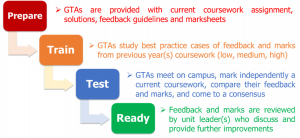Enhancing Feedback on Continuous Assessment

Mauro Luberti is Lecturer and UG Programme Director in the Department of Chemical Engineering since 2022. Over the last two years he has aimed to enhance students’ feedback focussing on continuous assessment, which is deemed more valuable and more promptly actionable for students prior to the final examination. This came as a result of a training on feedback at Faculty level called “PAL Improving Feedback”, the implementation of a successful feedback strategy as well as the sharing and support of this strategy to the Department and further follow ups with colleagues.
Feedback in Higher Education
One of the main aims of giving feedback is to provide specific information to help close the gap between what is understood and what is aimed to be understood, and so help to achieve a desired outcome (Robinson et al., 2013). However, in the last two decades student ratings on feedback satisfaction have been generally lower than other teaching elements within the UK higher education sector, highlighting procedural elements, the level of guidance offered and the lack of understanding of comments, as main issues of concern (UK Department for Education, 2023).
As common procedure in the School of Engineering, coursework reports are marked by GTAs and moderated by unit leaders. However, it has been extensively reported that GTA marking can be very inconsistent with extremely short feedback, sometimes limited to a “good” for a report section. As a result, academics usually receive a lot of students’ complaints and they end up remarking some reports almost entirely from scratch.
Feedback Implementation
As a Lecturer in Chemical Engineering, I am the leader of a Year 4 unit, whose assessment consists of 20% online test, 30% coursework and 50% final examination. This year, I had the chance to actively engage with discussions about what features make feedback to students effective, including “timely”, “legible”, “specific”, “goal-oriented”, “constructive”, “actionable” and “visible” (Nicol and Macfarlane‐Dick, 2006), and what are the three stages of effective feedback, i.e., feed-up, feedback and feed-forward (Hattie and Timperley, 2007). Furthermore, formative feedback should give concrete suggestions and enable students to develop and improve within the unit and, at the same time, the given feedback should result in an improvement in the final examination.
Accordingly, I devised a workflow for GTA training in order to guarantee effective feedback and marking consistency on coursework reports. The proposed workflow is based on the four steps “Prepare-Train-Test-Ready” where a detailed description of each step is shown in the figure below.

Before the “Test” step of the workflow I also organized a preparatory meeting in which I clearly coordinated the GTAs on the following:
- Consistency and integrity of marks and feedback are essential
- GTAs should mark the reports as a “single person”, thus communication is key
- Marks should be justified in detail by the feedback provided
- The feedback should focus on the critical discussion of the results
My efforts have ultimately led to an incredible result: not only the GTAs were well prepared for the marking process, but I received virtually zero complaints from students about marks and feedback! Compared to last year, the UEQ rating of “The feedback that I received on my work was helpful” increased by 8% and one student commented: “I’ve never had a course where the unit leaders were so happy to help the students learn more and provide such useful feedback”.
Feedback Support
After discussing with the Discipline Head of Education, I prepared and delivered an interactive presentation on student feedback to the whole Department of Chemical Engineering during this year Teaching Away Day. The turnout for the session was very good as around 30 academics were present. I structured the presentation to first provide an overview on student feedback principles and means to make feedback effective. I then delved into sharing best practice for feedback on continuous assessments focussing on group coursework and showing the above workflow for GTA training. We then brainstormed on categories of coursework written feedback and I coordinated the discussion using the group coursework of my unit as a case study, providing written feedback examples with different marks.
At the end of the journey, there has been a unanimous consensus that we should try to cover most of the feedback categories for each piece of coursework if we really want to make a difference in the overall student feedback. After the Teaching Away Day, I had some follow-up discussions with colleagues interested to learn more about the written feedback categories and the details on how to implement the workflow for GTA training. It has been very rewarding for me that two colleagues in the Department adopted some of the above strategies and confirmed that the student feedback scores improved in their units by 5%.
Feedback Extension
Colleagues working in STEM disciplines could promptly adopt the proposed GTA training workflow in units having an individual- or group-based written coursework marked by GTAs. However, a similar approach might also be used by colleagues working in the Faculty of Humanities where a unit ILOs are assessed through essays marked by GTAs. In this context, one could ask the GTAs to gather in campus, mark independently an exemplary essay, compare feedback and marks, and come to a consensus, which, would then be further discussed with the unit leaders. In addition, the GTA workflow training could be easily adapted to mark oral presentations in a consistent way.
I hope that this blog will reach more and more colleagues at UoM and please feel free to get in touch if you want more information about the GTA training workflow!
References
Hattie J., Timperley H. (2007) The power of feedback. Review of Educational Research 77, 81–112.
Nicol D.J., Macfarlane‐Dick D. (2006) Formative assessment and self‐regulated learning: a model and seven principles of good feedback practice. Studies in Higher Education 31, 199–218.
Robinson S., Pope D., Holyoak L. (2013) Can we meet their expectations? Experiences and perceptions of feedback in first year undergraduate students. Assessment & Evaluation in Higher Education 38, 260–272.
UK Department of Education (2023) Available at: https://www.gov.uk/government/organisations/department-for-education







0 Comments